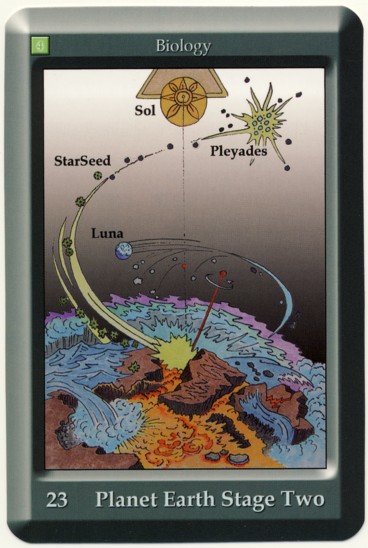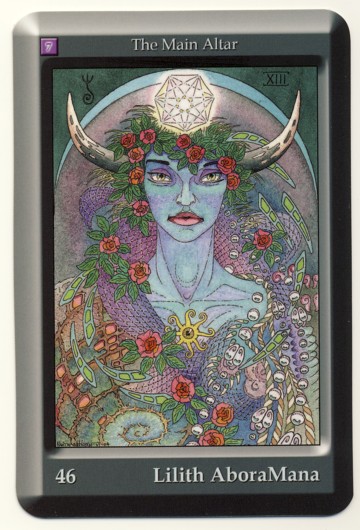
This deck is the creation of Neithard Horn, a German born during WWII who’s worked an incredible range of jobs while traveling around the world. While some may find the notion of a Goddess-oriented deck created by a man strange or jarring, Horn’s life path is one few Americans can begin to fathom. He spent five years living in a cave on the Canary Islands while channeling images for this deck.
The packaged kit includes the 79-card deck and the 176-page AboraMana Wisdom Script in a custom lift-top box. The 79 cards are organized into eight planes (or groups). There are seven “Joker” cards that are mixed and drawn separately at the beginning of a reading, while the remaining cards are shuffled and placed into a spread described in the book. Overall production values are high.

The cards feature beautiful but problematic artwork. Horn is a capable visionary artist with a gift for subtle and lovely colorizing. Image composition is excellent, and his complex ideas are executed with evocative imagery and deft original symbolism. The problems arise with his European gloss: Americans may find the female nudity excessive. Goddess imagery marketed to the American pagan community is simply not this breast-intensive. This isn’t a censorious observation so much as a consumer advisory. Horn’s work is art, not pornography, but it toes a line that not all viewers will find comfortable.
In the book, Horn writes about his inspiration for the deck and describes his conceptual content, ideas and feelings about the cards. Like the artwork, the book is problematic. The writing is uneven. Some card descriptions are overwritten while others have a scant line or two. The artist doesn’t give the reader a good idea of what the cards will actually mean in a reading. There are numerous tangential “lectures” (i.e. rants) and asides interspersed in the format irrelevant to the deck and the reading process. This makes the book more difficult to use. There is a single layout provided at the end of the text. The diagram and explanation of how to read this spread are inadequate.

Maybe this is such an obvious point that someone missed it: a visionary visual artist with no previous writing experience should be guided with a strong editorial hand. The author’s English is acceptable, but there are gaffs that should have been fixed. Additionally, the book would have benefitted from collaboration with an experienced author with experience in divination techniques. Since editorial guidance or divinatory expertise weren’t supplied, there is a gaping hole between the artist’s elaborate concept and the reader’s ability to actually gain any wisdom from a card layout.
The cards emerged from a visionary concept of great scope, inspired creativity, and genuine devotion to the Mother Goddess and all of her aspects. The critical secondary component, the book, fails to provide useful oracular insights. Even readers with psychic talent for drawing meaning from imagery will be challenged. This is a one-artist gallery show with an explanatory catalog by the artist, and a barely functioning oracle deck. My guess is that this product will primarily appeal to Europeans, to individuals with an educated artistic palate and cosmopolitan tastes, and to collectors.
~review by Elizabeth Hazel
Author: Neithard Horn
Schiffer Publishing, 2011
Boxed set with 79-card deck and 176 page book, $34.99
Originally published in the American Tarot Association Quarterly Journal, Summer 2011 issue
